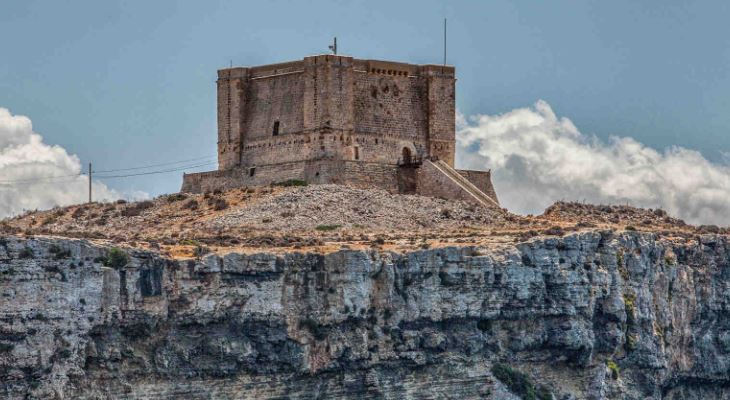This isolated tower is not one to be overlooked.

viewingmalta.com / Gregory Iron
The Santa Marija Tower, more commonly known as the Comino Tower, is a bastioned watchtower built in 1618, the fifth of six Wignacourt Towers commissioned by Grandmaster Alof de Wignacourt. This early system of towers was set up to facilitate defence and communication between the Cittadella in Gozo and Mdina, and this week, Comino's Tower turns 400 years old!
Gozo Minister Justyne Caruana visited the little island to commemorate the occasion along with volunteers from Din l-Art Helwa, who participated in a symbolic ceremony and re-enactment of the events that led to the building of the tower 400 years ago. The tower was manned by HRGM members featuring Maltese Milizia for the occasion.
From the 15th to the 17th century, Comino was frequently visited by Turkish corsairs finding shelter in the hidden creeks and caves, just waited to attack defenceless boats heading towards Gozo loaded with much-needed supplies. In Maltese, Comino is called Kemmuna, an Arabic word which means ‘sheltered place’, so it makes sense that its caves were sought after by these marauders!
The tower is a large, square building with four turrets at a height of 12m, and is located approximately 80m above sea level. Out of all the Wignacourt Towers this is the tallest, having to communicate between both islands. During times of crisis, the tower was armed with eight 32 pounder, and ten 24 pounder guns, and manned by a garrison of 130 men. The Order of the Knights of St John also built barracks just a short distance away from the tower.
In the 17th century, Comino also served as a prison or exile for errant knights convicted of minor crimes and sentenced to the drudgery of manning the tower. Later on, during the British occupation, the tower was essential for the protection of the anchorage and communication between St Agatha’s Tower (the Red Tower) in Mellieħa and Fort Chambray in Gozo. It was during this period that the interior of the tower changed, when it was likely used as an isolation hospital.
Over the years, St Mary’s Tower has been exposed to the sea and strong winds, which caused stone deterioration. Naturally, vegetation consumed the tower, dislodging stone blocks, and vandalism also took its toll. Restoration of the Tower commenced in 2002 and the exterior was completed in 2004 by local organisation Din l-Art Ħelwa. It is now restored to its former glory, retaining most of its original features apart from the musketry gallery.
The Santa Marija Tower is open to the public on Wednesday, Fridays, Saturdays and Sundays from April to the end of October, between 10:30am and 3pm if the flag is flying, so don't miss your chance to visit this local gem before the season comes to a close at the end of the month!